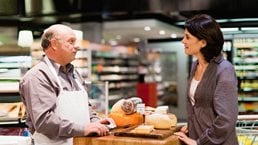Modernizing a cherished brand without alienating a loyal customer base or losing market share in a hypercompetitive marketplace is challenging. The hurdles include continuing to drive and maintain growth, choosing the right ideas for big results, knowing the customer, and innovating while staying true to the brand’s roots. Kurt Kane, chief concept and marketing officer at Wendy’s, spoke with McKinsey partner Stacey Haas and discussed how the restaurant chain tackled these challenges.
The ingredients for sustained growth
We’re now at 22 consecutive quarters of same-restaurant sales growth. And honestly, it’s due to a very simple formula that Dave Thomas put in place when he founded the chain back in 1969: put quality first, and be very specific with customers about the differences between Wendy’s and our competitors. Also, treat people with respect, and do the right thing.
Deciding how to drive growth
Some of our toughest debates about choices for driving growth often come down to which products to launch and what we can execute successfully in our restaurants.
There’s always a natural tension in the restaurant business between marketing and restaurant operations, because marketers are really good at creating fun ideas. But sometimes a new idea can put unfair stress on the restaurant without generating a big enough return to warrant the effort that goes into it. You have to make sure everybody’s grounded and everything you do is built around improving the economic model.
Modernizing the brand’s tone of voice
What I found is that our customers love the Wendy’s brand but have wanted us to modernize it for a long time. They’ve been rooting for the brand, love our food, and were hanging in there with us, even though the brand had gotten a little dated and tired.
So for us, the challenge was to bring those restaurants back to life in a very different way.
I think the thing that let us modernize our brand’s tone of voice, particularly in social, is that we’ve stayed grounded in what Dave Thomas did when he first started advertising Wendy’s nationally. He was always willing to pick a fight with the competition.
Knowing which ideas to pursue and which to reject
We test a lot of different ideas. Some of them work, some of them don’t, and some of them work great. I think the key thing is not doing those that only do okay. Those okay, safe, middle-of-the-road ideas rarely lead to a big result, and you can waste a lot of money, time, and energy very quickly. There’s a long list of okay ideas that we’ve decided not to do, and that’s allowed us to pick two or three big ideas and drive those out.
It can be hard to choose not to do something. There have been many times when I or other senior leaders on my team walk into a room and say, “Look, we’re not going to do that,” even though people have put their hearts and souls into it. That’s simply because it didn’t get a big enough result. But the work that was done got us to a jumping-off point to go find that bigger idea.

Marketing’s hidden treasure: Better CPE can unlock millions to fuel growth
Taking risks
You’ve got to be willing to get yourself in trouble now and then to get people’s attention. Probably my biggest troublemaking moment here at Wendy’s was the time we decided to release our own hip-hop album on social media, but we didn’t tell our franchise system, and we didn’t tell a lot of our key partners. We just decided to push it out. We didn’t know it was going to be as big as it turned out to be. But I didn’t do a good job of telling people what we were up to and why, because it was an idea that had been initially rejected or at least created a lot of concern. So my biggest troublemaking moment turned out to be a big success.
Turning customer knowledge into profits
Back in 2015, we invented a new promotional concept called “4 for $4,” where we gave people a complete meal solution for $4. It transformed the velocity of our business. We attracted a lot of new customers, and they were incredibly appreciative of the value they could get with the high-quality food we were offering.
The way 4 for $4 came about was by listening to customers, who were looking for a complete meal for under $5. So we looked at our menu and realized we could cobble together a great meal, a very filling meal, for under $5 if we cherry-picked the right items from the menu. Instead of forcing consumers to figure that out themselves, we just did it for them, and we immediately saw a massive lift when we bundled it all together.
Using data analytics to unlock creativity
To me, data has always been the way to unlock creativity. We had very specific data around what consumers were able to spend and what we could offer on our menu. We then had to solve that problem, because those two things weren’t working well together. We all sat in a room, put our creative minds together, and explored the ways that we could deliver. That’s when we invented 4 for $4. Then we had to challenge ourselves to make that concept interesting through advertising and communications.
Data is all about identifying the problem you’re trying to solve. Then you bring creativity to deliver solutions. Whenever you’re providing solutions for a consumer problem, your business grows.
Balancing spending between channels
We still do a lot of traditional media. We buy a lot of television, and we do that to spread awareness quickly about new initiatives we’re bringing to the market. There’s still no better way to do that. But television continues to get more expensive, so we’re aggressively moving more of our dollars into digital. What I do find, though, is the more disruptive we are with social, the less we have to spend. Because one of our rules on anything that we do in social—and through traditional media—is that we had better get a lot of press out of it.
We have only a quarter of the dollars that our largest competitor has to spend, so we need to make those dollars work extra hard. And we’ve been very fortunate that we’ve gotten a lot of media attention out of many of our moves, because we’ve had the courage to do some disruptive things.
Innovating while staying true to your roots
When you think about all the different food trends that are out there, and how Wendy’s can deliver well against those, I think the most important thing is to not chase a trend but stay true to what you do uniquely well.
For us, we did a lot of research. We asked people for all the different things that could motivate them to buy hamburgers, for example, and what they told us was that the most important thing we could do was deliver a hamburger made with fresh—never frozen—beef, hot off the grill.
So we’re really focused on communicating what makes Wendy’s different, what we’ve always done, versus trying to chase new trends that might be out there.


